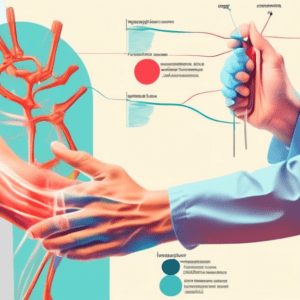What is Carpal Tunnel Syndrome?
Carpal tunnel syndrome (CTS) is a common condition that causes pain, numbness, and tingling in the hand and arm. It occurs when the median nerve, which runs from the forearm through a narrow passageway in the wrist called the carpal tunnel, becomes compressed or squeezed.
Causes of Carpal Tunnel Syndrome
The carpal tunnel is a small, rigid passageway made up of bones and ligaments. The median nerve and nine tendons pass through this tunnel. When there is swelling or any other cause of pressure inside the carpal tunnel, the median nerve can become compressed. This compression leads to the symptoms of carpal tunnel syndrome.
Common factors that can contribute to carpal tunnel syndrome include:
- Repetitive hand movements: Activities that involve repeated hand and wrist motions, such as typing, using a computer mouse, or assembly line work, can increase the risk of CTS.
- Forceful exertions: Tasks that require strong gripping or repetitive forceful movements can also contribute to the development of CTS.
- Awkward hand positions: Maintaining the wrist in a bent or extended position for prolonged periods can compress the median nerve.
- Underlying medical conditions: Certain health conditions, such as diabetes, rheumatoid arthritis, and thyroid disorders, can increase the likelihood of developing CTS.
- Pregnancy: Hormonal changes during pregnancy can cause fluid retention, which may lead to swelling in the carpal tunnel.
- Obesity: Being overweight or obese can increase pressure on the median nerve.
- Genetics: Some individuals may have a naturally smaller carpal tunnel, making them more susceptible to CTS.
Diagnosing Carpal Tunnel Syndrome
Diagnosing carpal tunnel syndrome involves a combination of a physical examination, patient history, and specialized tests. These tests aim to assess the function of the median nerve and identify any signs of compression within the carpal tunnel.
Physical Examination
A physician will conduct a physical exam to assess your symptoms and check for any physical signs of carpal tunnel syndrome. This examination may include:
- Evaluating your range of motion: The doctor will assess the flexibility and movement of your wrist, fingers, and hand.
- Checking for muscle weakness or atrophy: The doctor will examine the muscles in your hand and forearm for any signs of weakness or wasting, which can occur due to nerve compression.
- Testing sensation: Using a soft touch or a special instrument, the doctor will check for any areas of numbness, tingling, or altered sensation in your hand and fingers.
- Performing provocative tests: Specific maneuvers, such as Phalen’s test or Tinel’s sign, can help elicit symptoms and provide further evidence of carpal tunnel syndrome.
Electrodiagnostic Tests
Electrodiagnostic tests are essential for confirming the diagnosis of carpal tunnel syndrome and assessing the severity of nerve compression. These tests measure the electrical activity of the median nerve and provide valuable information about its function. Two common electrodiagnostic tests used in CTS diagnosis are:
Nerve Conduction Study (NCS)
An NCS measures the speed and efficiency of nerve impulse transmission along the median nerve. During the test, small electrodes are placed on the skin over the nerve. A mild electrical current is applied, and the time it takes for the nerve to transmit the signal is recorded. Slowed nerve conduction velocities are indicative of carpal tunnel syndrome.
Electromyography (EMG)
An EMG assesses the electrical activity of muscles. In CTS, the compression of the median nerve can affect the muscles it supplies, leading to abnormal electrical activity. During an EMG, a thin needle electrode is inserted into specific hand muscles. The electrical signals produced by the muscles are recorded and analyzed, revealing any abnormalities associated with nerve compression.
Imaging Tests
While electrodiagnostic tests are the primary tools for diagnosing CTS, imaging tests may be used in certain cases to rule out other conditions or identify contributing factors. These tests can provide visual information about the structures within the wrist and carpal tunnel. Imaging tests that may be considered include:
X-ray
X-rays can help identify any bone fractures, arthritis, or other structural abnormalities in the wrist that could be contributing to symptoms.
Magnetic Resonance Imaging (MRI)
MRI scans provide detailed images of soft tissues, including the median nerve, tendons, and ligaments. An MRI can detect any anatomical variations, tumors, or other soft-tissue abnormalities that may be compressing the nerve.
Ultrasound
Ultrasound imaging uses sound waves to create images of the structures within the wrist. It can visualize the median nerve and assess its size and shape. Ultrasound can also detect any swelling or thickening of the tissues within the carpal tunnel.
Importance of Accurate Diagnosis
Accurate diagnosis of carpal tunnel syndrome is crucial for determining the most appropriate treatment plan. Misdiagnosis or delayed diagnosis can lead to unnecessary treatments or the progression of the condition. Early diagnosis and intervention can often prevent permanent nerve damage and improve long-term outcomes.
Conclusion
Carpal tunnel syndrome is a prevalent condition that can significantly impact hand function and quality of life. Diagnosing CTS involves a comprehensive evaluation that includes a thorough physical examination, patient history, and specialized tests, particularly electrodiagnostic studies. Accurate diagnosis is essential for guiding treatment decisions and optimizing patient outcomes. If you are experiencing symptoms of carpal tunnel syndrome, seeking prompt medical attention is recommended to ensure proper diagnosis and timely intervention.
